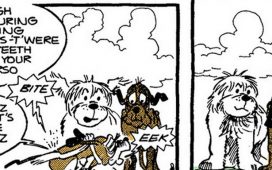On July 7, the Los Angeles County Sheriff’s Department made national headlines, for something other than having a long tradition of tolerating deputy gangs.
After a months-long investigation into an illegal marijuana grow operation in Los Angeles County’s Antelope Valley high desert that included “flight reconnaissance,” deputies pulled off “the largest operation ever to take place in the history” of the LASD: 131 arrests, 370,000 plants, and 33,480 pounds of pot—for a grand total of more than $1.19 billion in illegal weed, Sheriff Alex Villanueva announced at a news conference earlier this month.
Cannabis is legal in California, but only with a commercial license—and the “criminals,” whom Villanueva suggested were connected with either Mexican drug cartels or the Armenian mob—either or, you know—were almost certainly hurting the state’s legitimate cannabis industry with their illicit-market crops. In addition to the pot, Villanueva also seized weapons and cash.
But back to the value of the weed. One billion dollars. Billion, with a b. In late capitalism, there’s just something about that figure. It’s very big. It just sounds cool—and for Villanueva and his department, it resulted in some positive news coverage.
It is also, like almost every other drug bust estimate offered by police and dutifully recorded without a second thought by the news media, pure fiction—the product not of careful analysis or thoughtful economics, but fanciful, back-of-the-napkin fantasy math, experts contacted for this article said.
LOS ANGELES, CA – JULY 07: Los Angeles … [+]
Los Angeles Times via Getty Images
“Inflating valuations of drug busts in the press” is a “fairly common tactic in law enforcement,” as Alex Kreit, a law professor at Northern Kentucky University and director of the school’s Center on Addiction Law & Policy, said in an email.
“That’s not to say it is legitimate; I think it is incredibly misleading,” he added. “But I do believe it’s common.”
Common, and without consequence, as neither Kreit nor other experts contacted for this article knew of an instance in which law enforcement were reprimanded or even seriously questioned for offering absurdly inflated valuations for their work
Let’s briefly examine why Villanueva’s math doesn’t make any sense. $1.19 billion is a realistic estimate, only if the value of the cannabis seized was calculated on a per-gram, street-level retail sale price.
That’s not how wholesale pricing works—and, further, that’s not how cannabis cultivation works.
Yet, as Reason noted back in 2012, that’s exactly how estimating the size of narcotic busts work for police and sheriff’s departments.
Current wholesale prices for decent California sun-grown cannabis is, give or take, $1,000 a pound. Obviously, the more you buy, the lower the price—and the lower the quality, the lower the price
Even assuming the 33,480 pounds of cannabis was all worth $2,000 a pound, that’s only about $67 million worth of weed.
Assuming each of the 373,000 plants yielded a pound each, at the very generous price of $2,000 a pound, that’s $646 million—which, added together, leaves Villanueva’s estimate off only by about $400 million, or about 33 percent.
Los Angeles, CA – July 07: Sheriff Department photos of the massive illegal marijuana-grow … [+]
MediaNews Group via Getty Images
And those are extremely generous assumptions. There’s no indication each of the 370,000 plants was viable or mature, let alone a plant that yielded one pound or more of dried product. And there’s no indication that the cannabis was good enough to fetch $2,000 a pound.
Let’s say the weed was worth closer to $1,000 a pound. And let’s say some of those plants were small, or went herm, or got spider mites, or whatever. (Because all of that does happen!)
More probably, Villanueva overstated the value of giant drug bust—which, no doubt, was very big! That’s a lot of people, and a lot of pot!—by something close to a factor of 10.
That’s the kind of exaggeration that would get most of us laughed out of the bar, or fired from our jobs, or otherwise cost us our credibility.
“This is what lawyers call puffery—not exactly lying, but exaggerating [for] effect,” said another law professor, speaking on the condition of staying nameless.
By merely trying to figure out how Villanueva came at that very big figure, “My guess is that you’ve already spent more time thinking about this” than the sheriff did, the professor added.
The motivations for why law enforcement does this are very basic. The numbers sound cool, the numbers get repeated—and nobody ever questions them.
“As for why law enforcement does this, my sense is that it is really as simple as larger values make for bigger headlines and they very rarely get called out when they do it,” Kreit said. “I’m not aware of any instance of law enforcement being reprimanded in any formal way for inflating values in the press.”
Los Angeles, CA – July 07: Sheriff Department photos of the massive illegal marijuana-grow … [+]
MediaNews Group via Getty Images
In Kreit’s analysis, the sheriffs’ billion-dollar bust isn’t even the wildest drug bust inflation in memory. As the Philadelphia Inquirer reported, the Philadelphia District Attorney’s Office once claimed that 9,500 tabs of seized acid had a street value of $950,000—or about $100 per hit, or between 10 and 20 times what a $5 to $10 hit of acid actually costs.
If the sheriff’s bust yielded the equivalent of 6.4 million ounces of ready-to-sell cannabis—which it did not, but bear with us—at $200 an ounce, that’s about $1.2 billion.
“Of course,” Kreit added, “in my view, the practice of using retail prices for these estimates is incredibly misleading, because the average person is going to mistakenly think that the people arrested stood to gain the amount quoted by law enforcement (e.g., $1 billion in this case), when the value to the arrestees selling at wholesale would be much less than the retail price.”
Absent realistic police estimates, Kreit believes that the problem here is with the media. The media should either “consult an unbiased source” to get a more reliable estimate, or the media should tell their readers that the bust value is inflated.
“At the very least, I think it should be standard practice for the media ask law enforcement how they arrived at their estimate,” he added. “If the police used retail prices, it would be great to see that included in any reporting—e.g., ‘The police say that the marijuana could fetch $1 billion at retail, though its wholesale value is much less.’ “
Then again, the media is in the business of drawing eyeballs just as much as the sheriff’s department is here—and the outlet that throws a dose of cold reality on this all-smoke, no-fire situation risks losing eyeballs and clicks to another, less discerning publication.
So: everyone knows the numbers are fake, but everyone runs with them anyway. As far as hustles go, police’s drug-bust fantasy math is a win-win.








